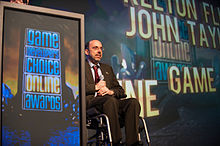Founding of Kesmai
In 1982 Flinn and Taylor founded the game developer Kesmai, and began working with CompuServe to offer multi-player games on a fee-per-hour basis. But once they began porting their code it turned out that the code that ran for free on the university's computer was hugely inefficient, and they burned $100,000 USD in computer time on CompuServe's system in three days before concluding they needed to rewrite their engine.
Kesmai's major titles include:
- Mega Wars III (1983) — Ironically, it was the chance to create Mega Wars III for CompuServe in 1983 that allowed Kesmai to adapt S for the system and make it available for online play. Another irony: Not one of the Mega Wars games are related to each other except by name; the original was based on the old university mainframe game DECWAR.
- Island of Kesmai (1985) — The rewrite of Flinn and Taylor's old text action adventure game went live at the end of 1985 after a long internal test cycle. It cost $6 an hour at 300 baud (the slow dial-up modems of the day), $12 for 1200 baud (the fast dial-up modems).
- Stellar Warrior (1985) — This rewrite of Mega Wars III introduced substantially simplified game play to expand its potential audience, and debuted on the GEnie online service the same day that Islands of Kesmai went live on CompuServe.
- Air Warrior (1986) — This game, offered on GEnie, is a key milestone in the history of computer games because it was the first commercial multiplayer online game to add graphics, displaying a 3D airplane dogfight environment. (The original Neverwinter Nights, which was the first MMORPG to use graphics, was not to debut until a full five years later in 1991). The original game was on the Apple Macintosh, and was followed by Amiga and Atari ST versions; the IBM PC version debuted in 1987. In another major innovation, Kesmai combined Mac, Amiga, Atari ST, and IBM PC players all in the same game, flying against each other.
- Multiplayer BattleTech: EGA (1991) — This title takes the Air Warrior concept to land-based Mech combat. The game had some problems with frame rate and latency due to the need for the computer to draw more terrain in land-based displays than it needed to draw when planes are flying in the air and much of the background is plain blue sky.
In the 1990s Kesmai was acquired by News Corp, which later sold it to Electronic Arts. The studio was disbanded, but EA continued to use the Kesmai name as a brand.
